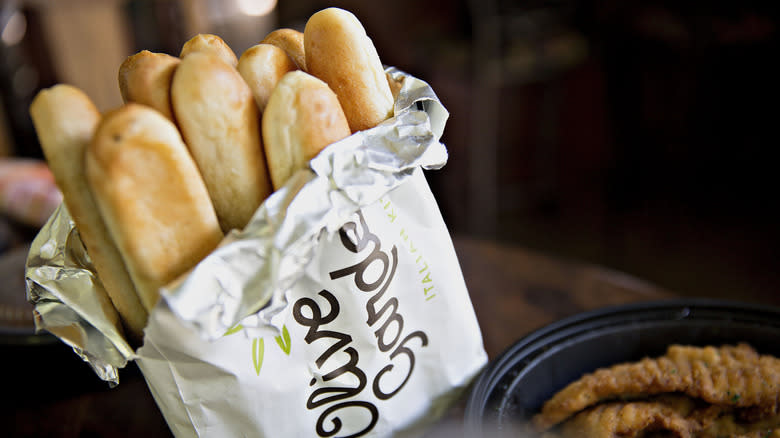How Olive Garden's Ingredients Help Keep Prices Low

Olive Garden may be a bit of a punchline to a lot of Americans, but there's no denying its popularity. Even if it occasionally makes up things like "pastachetti" and claims they're authentically Italian, or serves alcohol to children twice in a 13-month span, it's still an American icon. The biggest part of Olive Garden's success seems simple: It's just cheaper than most other major chains like it. This is a place that sold a never-ending pasta bowl for $13.99 in 2022. It's affordable, and people like the food.
So how can Olive Garden afford to offer deals like they do relative to their closest competitors? The answer is simple: Its operating costs are lower because its products are cheaper to make. You might think this means "it just uses the cheapest ingredients available," but that's not it; it's that the very nature of what Olive Garden sells makes it affordable to operate.
Read more: Fast Food Items That Caused A Lot Of Controversy
Olive Garden's Ingredients Just Cost Less

Think about it: Olive Garden's primary ingredient is pasta. Though the menu obviously isn't entirely pasta dishes, it sells more pasta than anything else -- and pasta is both cheap and filling. It can afford to shovel huge amounts of pasta dishes on customers because there's not much difference in back-end cost between an appropriately filling amount of pasta and an amount that will put you into a carb coma. Combine that with the fact their other ingredients are typically things like parmesan cheese, butter, eggs, and heavy cream, and you realize none of these are expensive.
This also means that while Olive Garden is cheaper than most chain family restaurants for the amount of food you're getting, the restaurant is still making an absurd profit compared to the majority of its direct competitors. It's typically ranked either at or near the top among full-service chains, both for customer satisfaction and profitability (where only Applebee's beats it, and even that's close).
Olive Garden Has Other Cost-Saving Tricks Up Its Sleeve

To be fair, this isn't the only way Olive Garden saves money on operating costs, and some of the others are maybe a bit more questionable. Its pay rates aren't amazing at $12 per hour minimum. But it's also doing some other surprising stuff, like only cleaning its carpets once a month. Allegedly, this preserves the quality of the carpets themselves, but let's be honest: Parent company Darden Restaurants is just trying to pinch a penny here. Olive Garden has also reduced the number of breadsticks it serves at one time (one per customer at the table, plus one extra) to cut down on food waste.
Whatever Olive Garden is doing, though, it's clearly working out well considering how much the company is raking in. Olive Garden may not have been created by Italians, but most Americans don't seem bothered by a lack of authenticity and are just happy to get a metric ton of pasta for less than $15.
Read the original article on Daily Meal.

